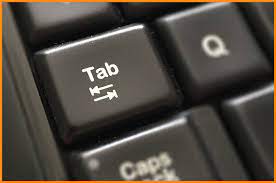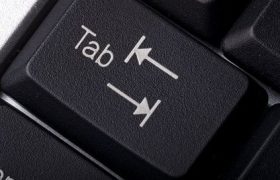The Tab key, also called the tabulator, was already an integral part of mechanical typewriter keyboards. Do you know How many spaces is a tab? Initially, this key facilitated tables and allowed you to switch from one column to another by pressing a simple button. Its functions are much broader on modern computer keyboards, even if they are not used often. We present, with practical examples, the most important functions that this key performs in application programs, in the browser and Windows.
What is the Tab key?
The abbreviation “tab” stands for the Latin term “tabulator,” which can be translated as “column.” This designation indicates the original function of the key. The Tab key allows you to arrange the data in a table in an orderly way and to move from one column to another in a document. This function is still available today in applications such as Microsoft Word or in the. Over time, however, the functions of the Tab key have multiplied, as explained in the section “What are the functions of the Tab key?”.

How many spaces is a tab?
8 spaces. We now also find many other function keys on modern keyboards, such as the Alt key or the Ctrl key. In our guide, you will find in-depth information on these keys and their functions, which are rarely fully exploited. Keep reading: How it feels to chew 5 gum
Where is the Tab key on the keyboard?
The Tab key is located on the keyboard’s left edge above the Caps Lock key and to the left of the [Q] key. The Tab key is recognizable by two opposite arrows, located one above the other and point to a line. On Swiss keyboards, the key often also has the wording “Tab.”
What are the functions of the Tab key?
The Tab key allows for a variety of functions. The action performed by pressing the key depends on the cursor’s position at that moment and the program being executed.
In programs such as MS Word, pressing the Tab key moves the cursor to the right by a specified distance, the so-called tab stop. This also corresponds to its original function, which it had on typewriters. If the cursor is in front of a word, it is moved to the right by one Tab. This feature is useful for creating even spacing, thereby increasing the distance from the left edge, splitting text into columns or blocks of text, and highlighting lists with spacing, all by pressing a single key.
Some applications replace the area with spaces. Others insert their tab characters or character codes and thus make the text formatting visible. In any case, the tabulator is a precisely defined but empty area. Although it consists of several characters, word processing programs combine the area and treat it as one. This allows you to skip the area to the left or right with a single click of an arrow key.
Some applications, including Word, offer the ability to customize the distance size. Activate the “Ruler” function in the “View” tab and use the left mouse button to set the point where you want to jump by pressing the Tab key. In Microsoft Word, the default tab stop position is 1.25 cm. This means that when you press the Tab key, the cursor jumps to the right by 1.25 cm.
Programmers use the Tab key to indent lines of code and then highlight hierarchies. This makes the source code much clearer and facilitates its work.
Read also: Top 50 apps for rooted phones
In the browser: navigate between text fields and on web pages
On web pages, the Tab key allows you to switch from one element to another. Typically, these are input fields such as name and address for forms and navigation elements on websites, such as a link or button. If you press the Tab key on a website, the cursor automatically jumps to the next link. The currently selected field is highlighted by a thin border and is active to be filled in. By pressing Enter, you confirm the current selection. This function allows you to browse websites using only the Tab key without using the mouse.
The Tab key is marked with two opposite arrows. This indicates that the direction of the function can be changed. To do this, press the Shift + Tab buttons at the same time. The Shift key reverses the direction so you can select items to the left.
In Windows: change windows
In Windows, you can use the key combination [Alt] + [Tab] to open a preview of all currently open windows and programs. By pressing the Tab key while holding down the [Alt] key, you can change the foreground window until you reach the desired one. Once you have reached the window of your interest, release both buttons and continue working as usual.
The Microsoft operating system also allows you to take advantage of other keyboard shortcuts to facilitate navigation. With the shortcuts to the Windows keyboard, you can then greatly simplify the work.
On operating systems: complete commands
In the Windows, Linux, and macOS command-line programs, you can use the Tab key to automatically add the commands you enter. It’s an interesting option, for example, in the Windows command prompt, to jump to a specific directory more quickly. For example, just enter “cd prog,” use the Tab key and confirm with the Enter key and the program will automatically take you to the “Programs” folder. If you want to go to another folder starting with “prog,” press the Tab key repeatedly until the command prompt displays the desired directory. This works, of course, with other CMD commands as well.

